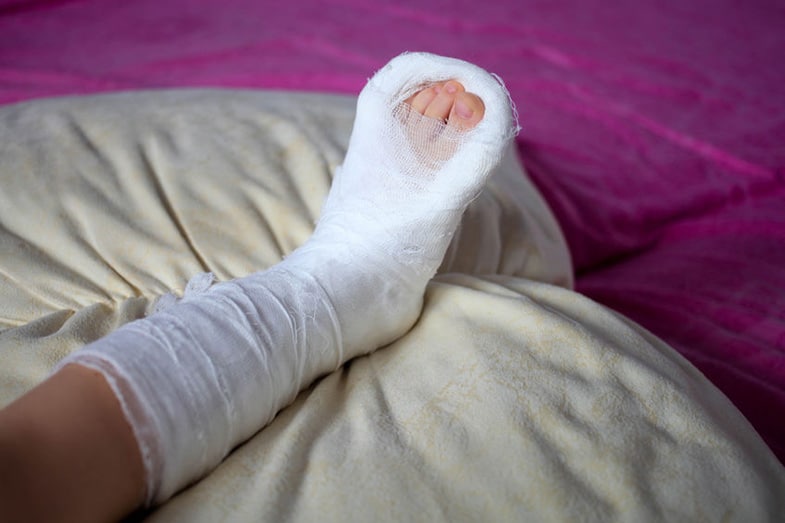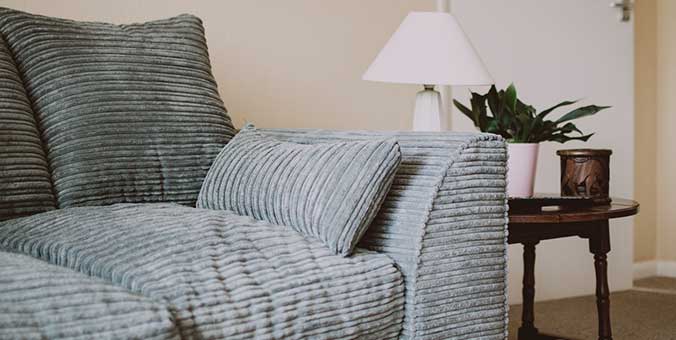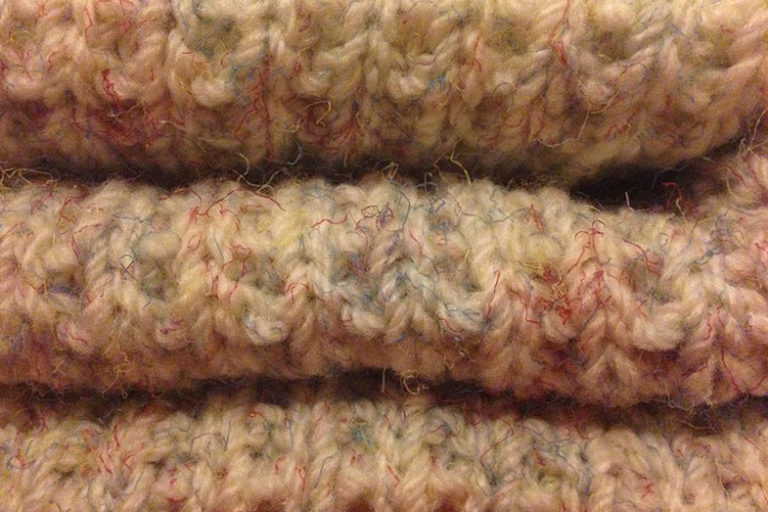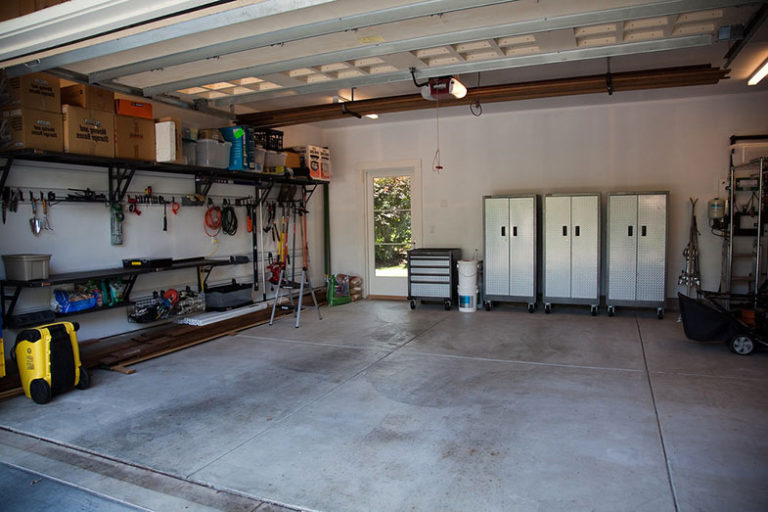How to Sleep with a Broken Leg
Disclosure: We may get commissions for purchases made through links in this post.
Sleeping with a broken leg can be frustrating. The sudden jolts of pain and uncomfortable positions are enough to throw off your sleeping pattern for the next 6 to 8 weeks, or until it’s healed. Before you give up hope and accept your sleepless fate, here are some things you can try to get a good night’s rest.
How to Sleep with a Broken Leg:
- Take pain medication as advised by your doctor.
- Lie on your back.
- Elevate your injured leg above your heart onto several pillows.
- Sleep in the middle of the bed to avoid falling off.
- Surround yourself with pillows and blankets to avoid rolling.
- Try sleeping on the couch if the bed is uncomfortable.
- Dress comfortably.

Pain Medication
Without pain medication, dealing with a broken leg can be difficult. Sometimes the pain is so severe; you may need to follow a prescribed treatment to help get you through the night. Consult with your doctor to determine the best way to manage your pain. He will write you a prescription for painkillers and instructions for taking them.
Certain kinds of pain medication should be taken as prescribed by your doctor. Some common side effects of painkillers include drowsiness, mood swings, poor memory, and slower reaction time. Other, more serious effects may involve diarrhea, constipation, and vomiting. Abuse of pain medication can lead to brain or liver damage.
Over-the-Counter
When the pain is less severe, over-the-counter medication, such as acetaminophen (Tylenol), may be recommended by your doctor. Anti-inflammatory drugs such as ibuprofen and aspirin, are not recommended, since they may, in fact, slow down the healing process. The reason for this is that they prevent the production of chemicals created in the body, specifically for healing broken bones. When taking the medication, follow the instructions on the label closely to avoid any serious health complications.
Elevate Your Leg
Keeping your broken leg elevated is important for getting better sleep. It reduces blood flow to the injury and helps you to relax since there are less pain and swelling. When the swelling goes down, the leg can heal faster. Elevating your leg can be done in a process called, RICE. The RICE method is more common for less serious injuries such as sprains, but some of the techniques are beneficial to know and can prevent soreness while you sleep.
RICE Method
Rest:
Following an injury, rest as much as possible to avoid further complications to the affected area. Take your full weight off your leg and just let it sit.
Ice:
A broken leg will usually be wrapped in a giant cast, so this step is more geared towards minor injuries such as sprains and general swelling. Ice the injury for 20 minutes every 4 hours for 2 to 3 days. Avoid application of the ice pack directly on the skin since it can cause damage. Instead, wrap it in a towel or shirt to serve as a protective layer. You can also use a bag of frozen peas if an ice pack isn’t available.
Compression:
Again, this is more related to a minor injury; however, following the removal of the cast, there may be slight swelling that could benefit from compression. Wrap the injury in gauze or some related material to decrease swelling. Avoid wrapping it too tight as this can cut off blood flow. Compress for about 2 to 3 days and then check the progress of the injury.
Elevation:
Keep your leg above your heart so that blood flow can move away from the injured area and avoid swelling.
Some pillows are specially designed for leg elevation. They provide a barrier to keep the leg in place and optimal support throughout the night. Check out the Memory Foam Leg Elevation Pillow on Amazon to find out more.
Position Your Pillows

Using pillows correctly can be very helpful in getting good sleep. Position the pillows in a way that is comfortable for you. This may take some adjusting and testing to find a relaxing position, so be patient. Make sure the leg is elevated enough to prevent swelling and in a safe enough position so that it doesn’t rock back and forth while you sleep.
One technique involves the positioning of three pillows:
- Place the first pillow horizontally at the foot of your bed. This provides the height and foundation for the next positions.
- Put the second pillow on top of the first pillow in a vertical position. It should be parallel to your leg and look similar to a ramp.
- Place the third pillow in the same position, vertically, but a little further back, closer to you. It should rest under your hamstring.
This setup provides proper elevation and support for your leg. When secured, it shouldn’t move around, causing you to wake up or feel any pain and discomfort.
If you don’t have pillows, you can use a big blanket (Amazon) or duvet. Fold it to increase the height or stack multiple blankets on top of each other. This provides a wider, elevated area, and limits the chance of your leg rolling off.
Another option is to purchase a specialized pillow for leg elevation. Skip building a leg support structure and use an orthopedic leg pillow, ergonomically shaped and designed for pain relief.
Stabilize Your body
Rest is extremely important for the healing process and also for your overall health. With a broken leg, it’s difficult and often frustrating to find a comfortable position to sleep in. When you finally find that position, you may still toss and turn during the night. To prevent that, your body should be completely stabilized to prevent any kind of movement that may wake you.
Before going to sleep, make sure your body is in a stable position to avoid any late-night interruptions. This involves moving back and forth or rolling over while you sleep. We discussed keeping your leg elevated while on your back, but what if you’re a side sleeper, and naturally tend to roll over. For this situation, first, determine which side you prefer to sleep on. You want to give extra attention to that side so that your body can naturally slope into it. Create a barrier of pillows or a rolled-up blanket directly beside you and tuck them slightly under your body to keep them in position. In the early stages of a leg break, you may want to avoid sleeping fully on your side, since you will want to prevent your non-broken leg from resting on top of it. Instead, use a barrier to allow your upper body to lean into and achieve that comfortable position.
Sleep on Your Side
Once the leg’s swelling has gone down, you may want to sleep completely on your side without elevating your leg as much. As you roll onto your favorite side, prevent the legs from sitting on top of one another. Keep one further forward away and the other slightly back. It’s important not to move your body during the night to avoid any painful or uncomfortable movements. There’s nothing worse than waking up to a jolt of pain. Keep the body still by getting creative with pillows and blankets.
Sleep on a Couch

If your bed just isn’t comfortable enough, try something else in the house, such as the couch. The couch allows you to try different positions you can’t achieve with the bed. Instead of just laying down in a flat position, try resting the injured leg over the backside of the couch. This keeps it well elevated and offers a comfy way to stretch out. You can also use the armrest to elevate your leg or switch around to elevate your head. Keep in mind that there might be a higher chance of rolling off your couch. Create a pillow barrier or pull the coffee table right up to it to avoid falling off.
If you don’t have a couch, try out other things around the house such as recliner chairs or a Yogibo. Experiment with different positions and find the one that is most comfortable for you.
Dress Comfortably
During the night, you want to be as comfortable as possible to avoid waking up. This involves staying cool and comfortable. Wear light and breathable clothing that won’t make you sweat, or even worse, itch under the cast. When the body is not at a comfortable temperature, the healing process for your broken leg can slow down, since being too cold or too hot can affect blood circulation. When this happens, the body is unable to find a relaxed position, thus keeps you awake throughout the night. Depending on the current temperature, whether it’s summer or winter, take a moment to determine what will be suitable to wear for bed. With a broken bone, comfortable clothes you should consider wearing to bed include:
- Lightweight clothing made from cotton, linen, or bamboo.
- If cold at night, wear light sweatpants and a long-sleeve shirt.
- Invest in high-quality pajamas designed to keep you cool during the night.
Itchy Skin Under Cast
Having an itch you just can’t get to may drive you crazy. If the skin under your cast bothers you during the night, here are some tips you can try.
The skin under the cast should be kept clean, cool, and dry. So before you try an relieve that itch with a ruler or some kind of sharp object, try using an anti-spray itch that kills bacteria and removes moisture. If purchasing a spray is not an option, use a strong fan to air out the arm, or apply an ice pack on the cast edge. This will cool your arm down and prevent it from sweating.
If those options didn’t work, consider using a Cast Scratcher which is flexible enough to get to all those difficult, itchy spots. It is also comfortable on the skin and easy to use.






